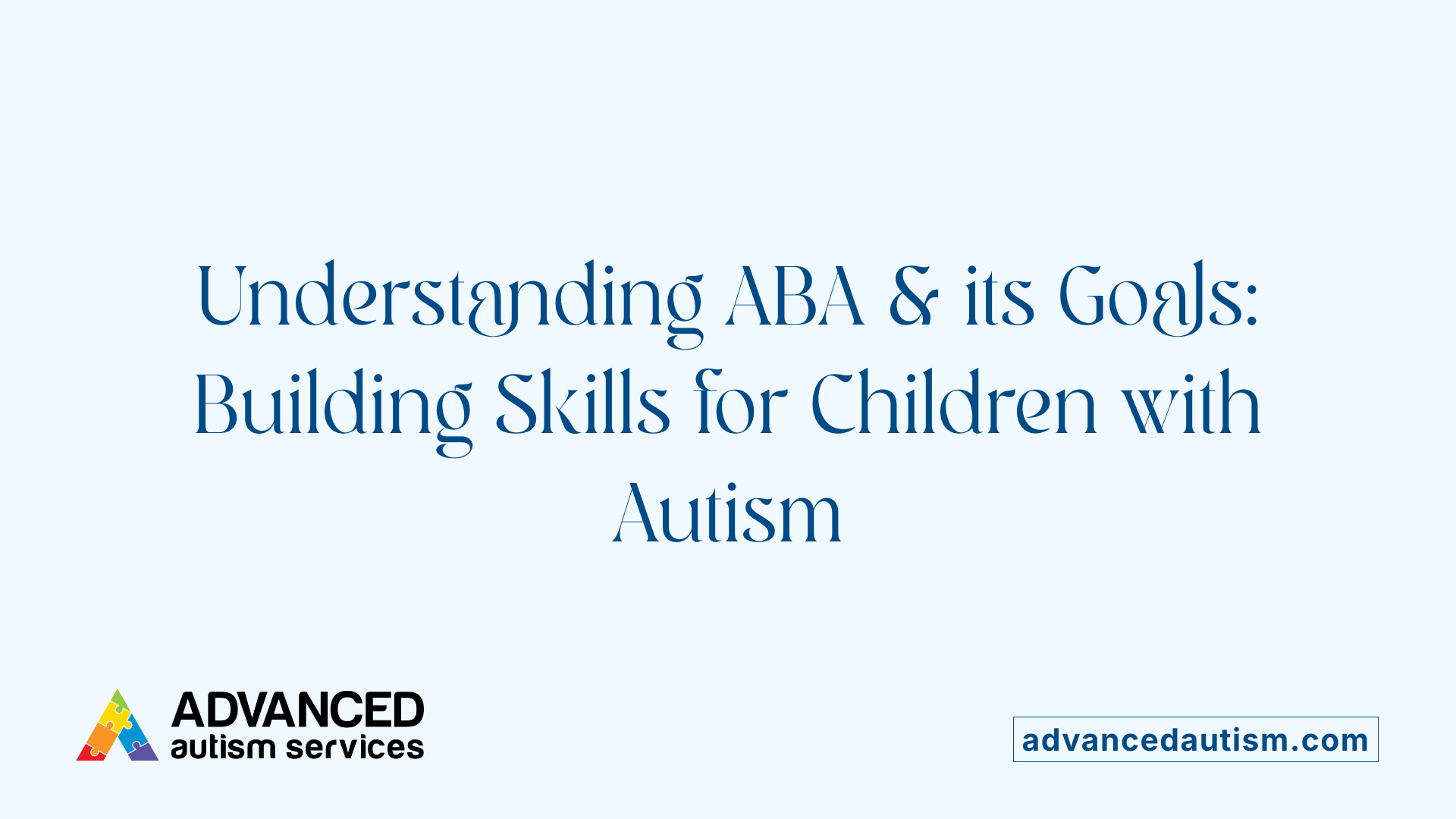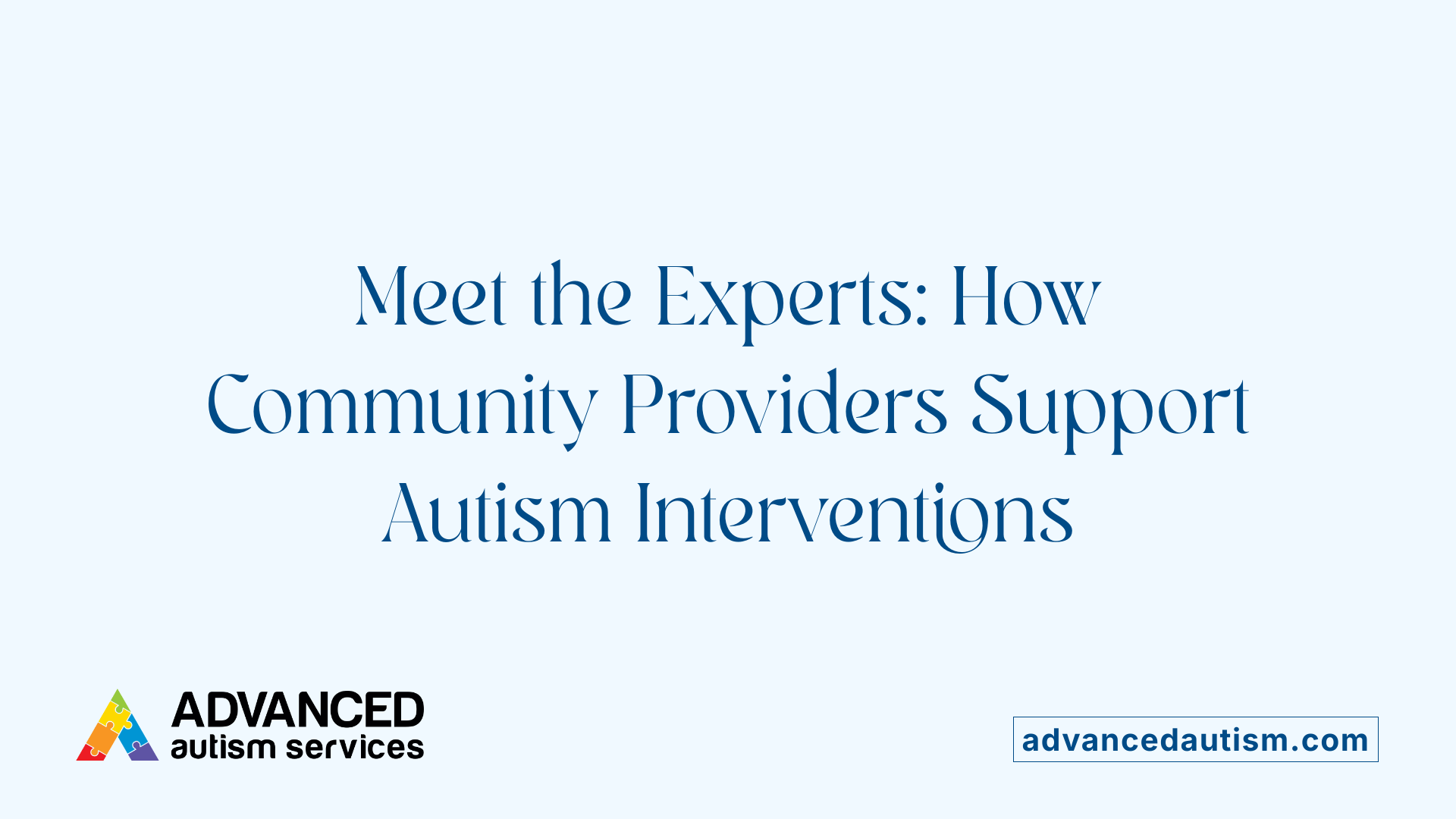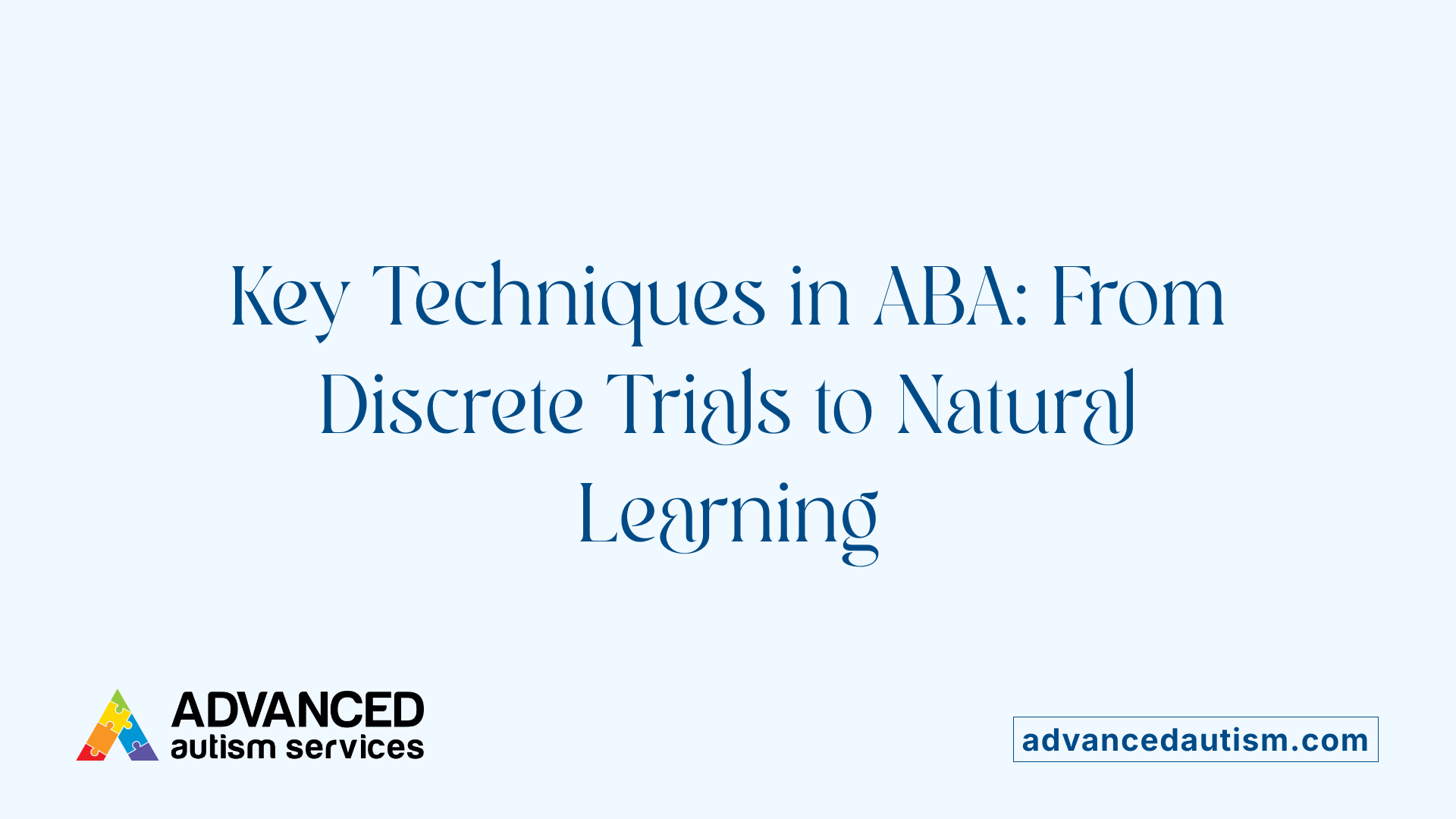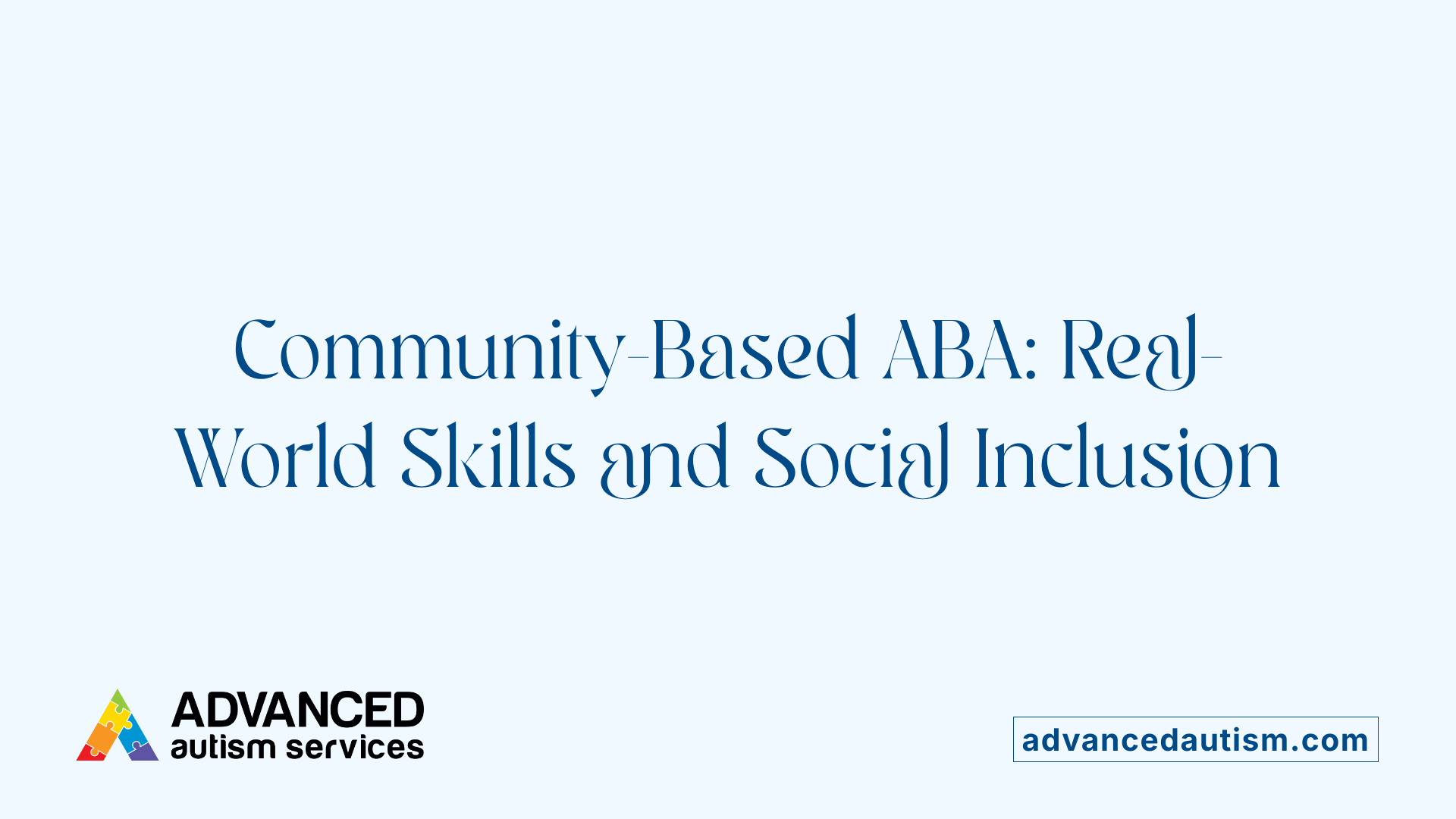How Community-Based Services Support Children with Advanced Autism
Empowering Children with Advanced Autism Through Community-Based Interventions
Understanding the Role of Community-Based Autism Services
Community-based services play a crucial role in supporting children with advanced autism spectrum disorder (ASD) by providing targeted therapies within real-world environments. These services focus on helping children generalize critical skills such as communication, social interaction, and daily living tasks beyond clinical settings, ensuring that progress translates into meaningful independence and improved quality of life. This article explores how behavioral analysis therapies, particularly Applied Behavior Analysis (ABA), function within community frameworks and how interdisciplinary care, insurance coverage, and Medicaid waivers contribute to comprehensive support systems for children with ASD.
Autism Therapy and Behavioral Analysis: Foundations and Goals

What is autism therapy and how does it incorporate behavioral analysis?
Autism therapy refers to various interventions aimed at helping individuals with autism spectrum disorder (ASD) develop crucial skills across social, communication, behavioral, and daily living areas. A central approach within autism therapy is behavioral analysis, specifically Applied Behavior Analysis (ABA).
What are the principles of Applied Behavior Analysis (ABA)?
ABA is founded on understanding how behavior works and how environmental factors influence it. It uses concepts like the ABCs of behavior — Antecedent, Behavior, and Consequence — to analyze and shape behavior. Positive reinforcement, a core technique, rewards desired actions to increase their frequency. ABA therapy is flexible and individualized, adapting strategies based on a person's unique needs and preferences.
What are the goals of ABA programs?
ABA aims to increase helpful behaviors and reduce those that are harmful or impede development. Programs focus on improving language and communication, attention, social skills, memory, academic abilities, and decreasing problem behaviors. They also promote self-care, play, motor skills, and independence.
How are individualized interventions structured?
Qualified professionals like Board Certified Behavior Analysts (BCBAs) design personalized ABA programs after thorough assessments. These interventions employ data-driven methods and ongoing evaluation, ensuring they meet the child’s goals efficiently. Therapy can be provided in various settings including home, school, and community environments, helping the individual generalize skills broadly.
ABA therapy stands out as a scientifically validated approach widely recognized by medical authorities. Intensive, long-term ABA intervention has demonstrated success in enhancing intellectual functioning and daily living skills, significantly improving outcomes for children with ASD.
Providers of Autism Therapy and Behavioral Services in Community Settings

Who provides autism therapy and behavioral analysis services?
Autism therapy and behavioral analysis services are delivered by trained professionals committed to supporting children with autism spectrum disorder (ASD). Central to these services are Board Certified Behavior Analysts (BCBAs), who design and oversee individualized Applied Behavior Analysis (ABA) programs based on thorough assessments. Registered Behavior Technicians (RBTs) work under BCBAs’ supervision, executing therapy sessions.
What specialists contribute to the therapy team?
Beyond BCBAs, therapy teams often include speech therapists, occupational therapists, psychologists, and other behavioral health specialists. Speech therapists focus on improving communication skills, occupational therapists assist with motor and daily living tasks, while psychologists may address co-occurring mental health conditions.
In which settings is therapy delivered?
ABA and related therapies are flexible and provided in multiple settings. Services can take place at home, in schools, clinics, or community environments such as playgrounds, libraries, and stores. Community-based therapy allows children to generalize learned skills across real-world scenarios, encouraging independence and social inclusion.
Why is caregiver involvement important?
Caregiver training is a vital component of effective therapy. Parents and guardians collaborate with providers to reinforce skills at home and support behavior change consistently. Training empowers families to navigate challenges and sustain progress outside of formal sessions.
This comprehensive, multidisciplinary, and community-focused approach ensures that therapy is personalized, practical, and holistic, emphasizing skill development and quality of life for children with ASD.
Core Techniques in Behavioral Analysis for Autism Therapy

What Are the Common Techniques Used in Behavioral Analysis for Autism Therapy?
Applied Behavior Analysis (ABA) therapy integrates several effective techniques to teach and support individuals with autism. At its core, ABA uses positive reinforcement—a strategy where desired behaviors are rewarded to encourage their repetition. This approach helps increase helpful behaviors while decreasing those that are harmful or hinder development.
Two prominent teaching methods within ABA are Discrete Trial Training (DTT) and Natural Environment Teaching (NET). DTT involves structured, repetitive teaching sessions that break skills down into small, manageable components. Conversely, NET promotes learning within natural settings, capitalizing on everyday activities to encourage spontaneous use of skills.
Functional Communication Training (FCT) specifically addresses communication by teaching individuals to express their needs effectively, often through gestures, signs, or Augmentative and Alternative Communication (AAC) devices. This helps reduce frustration and challenging behaviors.
ABA therapy also emphasizes continuous data collection to monitor progress. Therapists gather detailed information on antecedents, behaviors, and consequences (the ABCs of behavior) to tailor and adjust interventions accordingly.
These varied techniques create a flexible, individualized program overseen by qualified professionals, aiming to enhance communication, social skills, independence, and overall quality of life for individuals with autism.
The Unique Benefits of Community-Based ABA Therapy

What Is Community-Based ABA Therapy?
Community-based Applied Behavior Analysis (ABA) therapy delivers behavioral interventions in natural, everyday environments such as playgrounds, grocery stores, restaurants, libraries, and classrooms. This real-world integration allows children to practice new skills in contexts where they naturally occur, fostering meaningful learning and adaptability.
How Does It Help Generalize Skills?
One major advantage of community-based ABA therapy is the emphasis on skill generalization. Rather than restricting learning to clinical or home settings, therapy encourages children to apply communication, social, and functional skills across multiple environments. This approach ensures that children can adapt and consistently perform these behaviors in diverse situations.
Development of Social Skills in Community Contexts
Therapists focus on growing important social abilities like initiating conversations, taking turns, and engaging in cooperative play. Through guided practice in community spaces, children learn how to interact respectfully and effectively with peers and adults, helping them build friendships and bolster their social confidence.
Managing Challenging Behaviors in Real Time
Community therapists are trained to address challenging behaviors as they arise during outings and activities. They use calming techniques and positive reinforcement strategies on the spot, equipping children with coping skills and minimizing disruptions. This hands-on, immediate intervention supports smoother participation in everyday life.
Supporting Independence and Inclusion
Community-based ABA also promotes independence by teaching children to complete tasks autonomously, navigate unfamiliar environments, and apply learned skills without constant prompts. Additionally, it facilitates inclusion by helping children seamlessly engage in school and recreational activities, expanding their social networks and sense of belonging.
By blending therapy with natural environments, community-based ABA offers a practical, comprehensive approach tailored to empower children with autism to thrive socially and independently.
Navigating Insurance and Medicaid Support for Autism Services
What Does Insurance Coverage Look Like for ABA Therapy?
Many private insurance plans and Medicaid programs now cover Applied Behavior Analysis (ABA) therapy, which is a proven method for supporting individuals with autism spectrum disorder (ASD). All 50 states require commercial health plans to include ABA coverage, and Medicaid has also expanded this coverage, especially after guidance issued in 2014. However, coverage can vary from state to state, so it's important for families to verify their individual insurance plans before starting therapy.
What Are Medicaid Home and Community-Based Services (HCBS) Waivers?
Medicaid's Home and Community-Based Services (HCBS) waivers provide essential funding to support people with ASD in home and community settings rather than institutional care. These waivers cover a wide range of services including case management, respite care, family support, social skills groups, employment assistance, and therapies like speech and occupational therapy. Some states have autism-specific waivers, while others offer broader developmental disability waivers encompassing individuals with autism.
How Do You Apply for Medicaid Waivers and Who Is Eligible?
Eligibility for HCBS waivers generally involves medical and functional assessments, along with evaluations based on the individual's support needs. Financial criteria sometimes come into play as well. Since the demand for these services often exceeds supply, waitlists are common. When applying, families undergo detailed assessments, and if denied, they can appeal the decisions. Waivers are designed to be person-centered, allowing individuals to choose providers and manage care either by themselves or through agencies.
What Services Are Covered Through Medicaid Waivers?
- Case Management
- Transportation
- Home Health Care
- Respite Care
- Adult Day Services
- Employment Support
- Assistive Technology
- Speech, Occupational, and Physical Therapy These services collectively work to help individuals live safely, independently, and participate actively in their communities.
How Are Waitlists Managed and What Interim Supports Are Available?
Since waitlists can lead to significant delays, families are encouraged to explore other supports while waiting. These include Supplemental Security Income (SSI), health insurance-covered therapies, community organization programs, and transportation services. In addition, many families receive help through educational planning and community-based programs such as social skills groups and parent coaching.
This multi-layered insurance and Medicaid landscape plays a vital role in ensuring children and youth with autism gain access to necessary therapies and support systems progressively throughout their development.
Comprehensive, Interdisciplinary Care: Enhancing Outcomes for Children with Autism

What is the role of interdisciplinary teams in autism care?
Interdisciplinary teams play a crucial role in delivering effective care for children with autism. These teams typically include behavior analysts, speech therapists, occupational therapists, psychologists, and other healthcare professionals working collaboratively. Their combined expertise ensures a holistic approach to addressing diverse developmental needs.
How are speech, occupational, and behavioral therapies integrated?
Speech therapy focuses on improving communication skills, including functional communication like requesting help or expressing needs. Occupational therapy supports motor skills, sensory processing, and daily living tasks. Behavioral therapies, especially Applied Behavior Analysis (ABA), aim to increase positive behaviors and reduce challenges. These therapies are coordinated to complement each other, enhancing skill development and generalization across environments.
What family education and caregiver coaching are provided?
Family education and caregiver coaching are integral components of interdisciplinary care. Parents and caregivers receive training to support the development of appropriate behaviors and daily living skills at home and in the community. This coaching empowers families to maintain consistency and promote independence, reinforcing therapy goals outside clinical settings.
How is school and educational support incorporated?
Educational planning is a key aspect, with service navigation helping families identify suitable school placements. Interdisciplinary teams collaborate with educators to support inclusion and tailor interventions to school environments. Community-based ABA therapy, for example, assists children in practicing social and communication skills directly within classroom or recreational settings.
How do community resources fit into this approach?
Coordination with community resources, such as case management, respite care, and social skills groups, enhances overall support for the child and family. Programs like sibling support groups and mindfulness training foster emotional well-being and social connection. Medicaid waivers and insurance coverage facilitate access to these diverse services, ensuring continuity and comprehensive care beyond clinical therapies.
Addressing Social and Emotional Needs Through Community Programs
What Group-Based Social Skills Programs Are Available?
Group-based social skills programs, such as PEERS®, provide children with autism structured opportunities to practice making friends, managing social situations, and reducing related anxiety. These programs focus on teaching practical social strategies in a supportive group environment.
How Is Cognitive Behavioral Therapy (CBT) Used?
CBT is commonly used for young people with autism who also experience co-occurring conditions like anxiety, OCD, depression, or ADHD. This therapy helps manage emotions and behaviors to improve overall mental health.
What Family and Sibling Support Groups Exist?
Family and sibling support groups offer education, peer connection, and shared strategies to cope with the challenges of autism. These groups help strengthen family dynamics and provide a space for siblings and caregivers to express their experiences.
Are There Mindfulness or Neurodivergent-Focused Education Programs?
Mindfulness programs—like MYmind—assist children with neurodivergencies and their families by teaching calming techniques and stress management. These programs promote emotional regulation and overall well-being.
How Does Service Navigation and Transition Planning Assist Families?
Service navigation supports families in coordinating care, school placement, and planning for transitions, such as moving from childhood to teenage years. This community-oriented approach ensures that families receive comprehensive guidance tailored to their needs.
Conclusion: Fostering Independence and Quality of Life Through Community-Based Supports
Community-based services that incorporate behavioral analysis, especially Applied Behavior Analysis (ABA), offer essential, evidence-based support tailored to the diverse needs of children with advanced autism spectrum disorder. By situating therapy within real-life environments, these services promote meaningful skill generalization, social inclusion, and independence, while interdisciplinary care teams and robust insurance and Medicaid frameworks ensure access and continuity. Additionally, family-centered education and social-emotional programs integrate comprehensive support, helping children and their families navigate the complexities of autism. Together, these elements form a dynamic support system empowering children with autism to thrive in their communities and live fuller, more connected lives.







